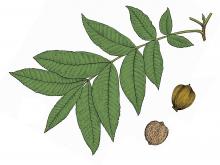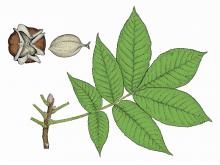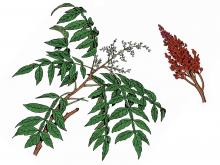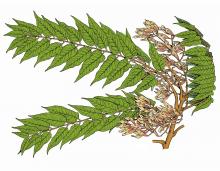Trees, Shrubs and Woody Vines
Media

Species Types
Scientific Name
Carya aquatica
Description
Water hickory grows on ground that is often under water during part of the year. The bitter nuts are consumed by ducks and other wildlife.
Media

Species Types
Scientific Name
Juglans cinerea
Description
Butternut, or white walnut, is closely related to the more common black walnut. Both have delicious edible nuts, and both are valued for their wood. Butternut, however, is declining due to a usually fatal fungal disease.
Media

Species Types
Scientific Name
Carya tomentosa
Description
Missouri is rich with hickory trees. Mockernut hickory stands out from the rest for its hard wood, thick-shelled fruit enclosing relatively small kernels, large and light-colored terminal buds, and tight, never shaggy, bark.
Media

Species Types
Scientific Name
Rhus aromatica
Description
Unlike its cousin poison ivy, fragrant sumac is a peasant, nontoxic plant. Note the middle leaflet of its "leaves of three": On fragrant sumac, there is no (or at most a very short) leaf stalk on that middle leaflet. Also, fragrant sumac has hairy, reddish fruits (not waxy whitish ones).
Media

Species Types
Scientific Name
Parthenocissus quinquefolia
Description
Occasionally confused with poison ivy, Virginia creeper is easily identified by simply noticing that most of its leaflets are in fives, instead of threes. This common native vine is useful in landscaping.
Media

Species Types
Scientific Name
Rhus copallinum
Description
Winged sumac is most common south of the Missouri River. The "wings" in the name refer to the narrow, flattened leafy structures running along the central stems of the compound leaves.
Media

Species Types
Scientific Name
Ailanthus altissima
Description
Tree-of-heaven is a fast-growing exotic that is common in urban areas. It is weedy and aggressive and should not be planted. It has 2-foot-long feather-compound leaves. Twigs smell unpleasant when you break them.
Media

Species Types
Scientific Name
Rhus spp.
Description
Sumacs are shrubs or small trees that often form colonies from their creeping, branched roots. The foliage usually turns brilliant shades of red in early autumn. The clusters of berrylike fruits are red.
Media

Species Types
Scientific Name
Toxicodendron radicans
Description
Poison ivy is a toxic plant that contains an oil in all its parts that, if you come into contact with it, can cause an intense skin reaction. Learn to recognize it, and sidestep it on your outings.
Media

Species Types
Scientific Name
Parthenocissus vitacea (syn. P. inserta)
Description
Woodbine is a climbing woody vine that usually sprawls over bushes and rocks. Its leaves have five coarsely toothed leaflets. Unlike the closely related Virginia creeper, its tendrils generally lack sucker disks. It is rarely found in Missouri.
See Also
About Trees, Shrubs and Woody Vines in Missouri
There are no sharp dividing lines between trees, shrubs, and woody vines, or even between woody and nonwoody plants. “Wood” is a type of tissue made of cellulose and lignin that many plants develop as they mature — whether they are “woody” or not. Trees are woody plants over 13 feet tall with a single trunk. Shrubs are less than 13 feet tall, with multiple stems. Vines require support or else sprawl over the ground.





















